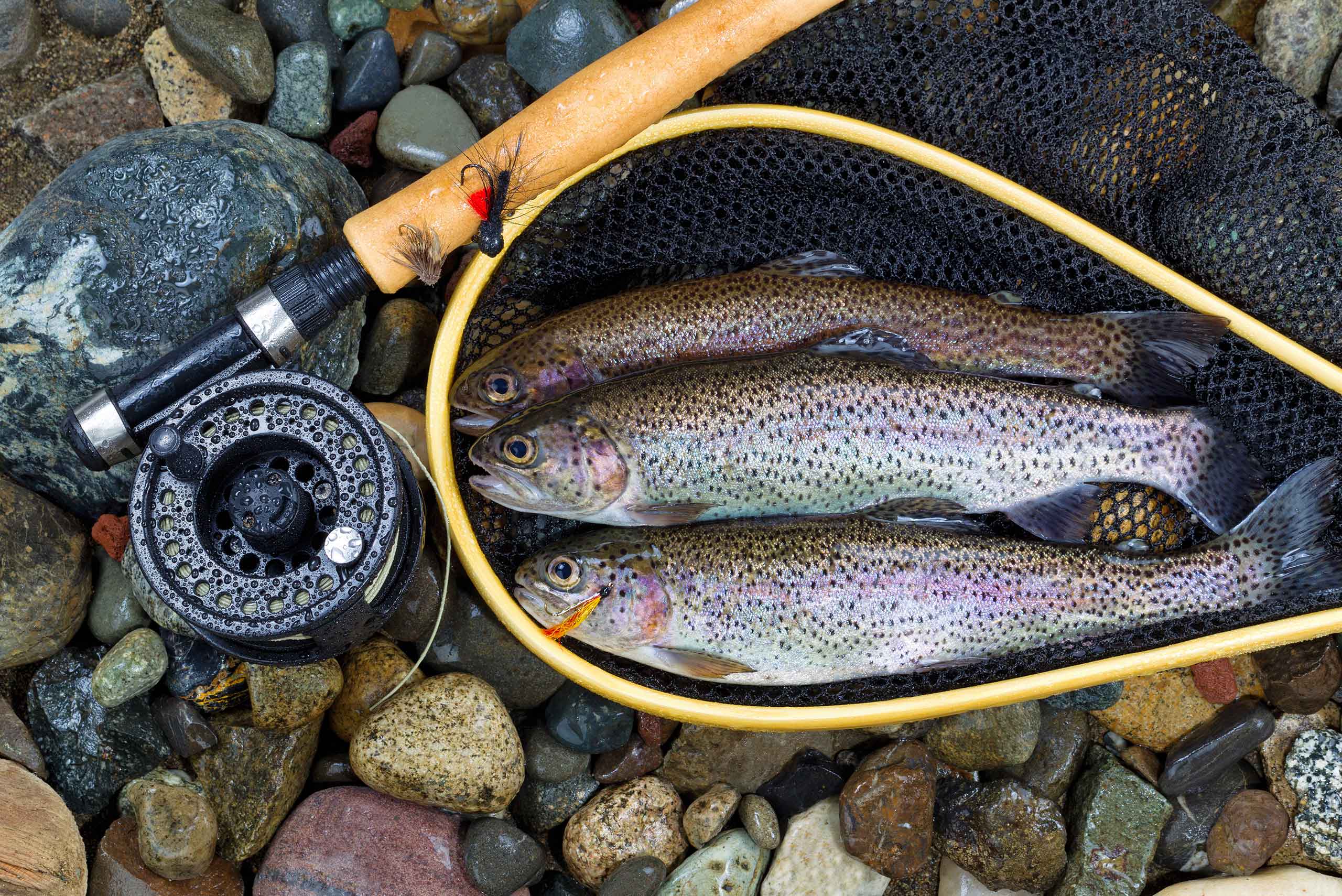
Fishing on Loch Tay and the rivers Lochay and Dochart
available from Bridge Park holiday cottage in Killin, Scotland
Trout
Brown trout are the indigenous species in Scotland and they exist in almost all natural waters, from the tiniest burn to the largest lochs. Sometimes they grow very big in lochs by feeding on smaller trout and charr; these fish are known as “ferox”. For the most part however wild trout of fifteen inches or more are highly regarded as sporting quarry by anglers. Although the trout season opens in March, fishing does not really pick up until April when large hatches of insects start to bring the trout to the surface for an easy feast. April, May and June offer tremendous trout fishing opportunities on the rivers and on many of the smaller lochs. Later in the season early morning and late evening provide the best chances of success during hot weather. Come September, the waters start to cool again and during the last few weeks of the season daytime hatches again occur. Trout fly-fishing divides itself neatly into two categories, rivers and natural lochs. The season for brown trout fishing is 15 March to 6 October.
Scottish trout vary tremendously in their characteristics from loch to loch and river to river. Their colours can be amazing, bright reds, yellows and orange, greens, indeed every colour in the rainbow. Their feeding patterns are quite varied also and so they can be caught on almost any fly or technique – provided that it is the correct one ! Many Scottish rivers offer excellent brown trout fishing. Some of the smaller waters also offer great opportunities.
Tackling river trout requires stealth and skill to outwit a natural creature accustomed and attuned to its environment. Clumsy presentation and thoughtless disturbance will produce little reward. However there are plentiful rewards for the angler who approaches the river with care.
Choice of fly
During the early part of the trout season wet fly and nymph fishing are the most reliable methods. Once the flies start hatching the fish respond by surface feeding, then dry fly fishing becomes the epitome of sport for most anglers.
A general-purpose nine foot river rod is perfect. Dry fly anglers often use shorter and lighter rods to achieve better presentation and enhance their chances of success.
Most river fly patterns are imitative and fortunately many of them represent a number of species of insects and so the angler does not require knowledge of the finer details of entomology.
Hares ear, pheasant tail, prince nymph, Czech nymphs, peeping caddis, killer bug and woven nymphs are very successful.
Gold head and tungsten-weighted versions are particularly effective for getting deep quickly. These patterns are usually fished with a short line “high stick” style or in conjunction with indicators. Traditional wet flies are normally fished in teams of two or three flies, chosen to represent the variety of insects that may be available to the trout. This method is best early in the season and Greenwell (winged), March Brown, Silver March Brown, Black and Blae, Snipe and Purple,
Blue Dun, Malloch’s Favourite, Wickham’s Fancy and Greenwell spider form the basis of most casts. Wet flies are most often fished “on the swing” but upstream wet fly fishing is a more skilled and deadly presentation. In recent years
Cul-de-Canard dry flies have proven their effectiveness, especially as emerger and dry patterns. A selection of these representing upwing and caddis insects is very useful throughout the season. Recommended conventional winged or hackled dry flies include Greenwells, Dark, Medium and Light Olives, March Brown, Yellow May Dun, Tups Indispensable, Red Quill, Ginger Quill, Adams, Elk or Deer Hair Caddis and Blue Winged Olive. For those occasions when nothing is rising, terrestrial patterns such as ants and small hoppers are useful for prospecting.
On the Scottish lochs the terminology used for a three-fly cast is point fly, dropper (or middle) and bob fly (the dropper nearest to the rod). The bob fly is so called because it is closest to the surface and as the line is retrieved and it can be made to skate and bob along the waves to represent a hatching or egg laying insect. Bushy flies that cause an attractive wake are often used for this purpose in the belief that they bring the trout up and if they don’t accept the bob fly they may take one of the others. Popular wet fly patterns include Kate McLaren, Bibio, Black Zulu, Blue Zulu, Soldier Palmer, Clan Chief, Kingfisher Butcher, Silver Butcher, Yellow Tail Greenwell, Black Pennel, Ke-He, Claret Pennel, Grouse and Claret, Teal and Green, Invicta, Silver Invicta, Green Peter, Dunkeld and a few dark coloured buzzers for occasions when the wind drops. Sizes 10 to 14 cover most conditions. Fairly light tackle is best. A fly rod suitable for a number 5 or 6 line, coupled with floating and intermediate lines will satisfy the requirements on most days.Travel rods are ideal where reaching the loch requires a long walk.
Pike
Pike are to be found in many of the lochs in Scotland and especially in many of the Perthshire Lochs, like loch Tay, where double figure specimens lie in wait for the fly fisherman during the summer months. Not that you need to catch a huge fish to get lots of excitement as these ferocious predators attach the bait fish imitating fly with gusto. Using an eight weight fly rod and a hard nylon leader reinforced by a short wire trace the sport that these fish provide is truly amazing.
Pike fly:-The weed guards are made from Mason Hard nylon and these allow the fly to be retrieved through snaggy weed beds with little chance of getting caught up or fouling. Pike can be caught on flies of any colour as long as they resemble something large enough to be considered prey by this fearsome predator.
Playing a pike on fly-here is some of the explosive action that pike fly fishing gives. When these fish turn on the heat their speed is truly surprising. Built for sprinting the pike gives its best on a fly rod with searing runs and frantic surface action. They do not possess the stamina of salmon, nor do they fight with the exhilaration of the sea trout, but in their own way they provide great sport. Barbless single hooks are easily removed and within a minute or two the fish are returned safely to the loch to fight another day. If you are getting bored with stocked rainbows a reservoir rod and a few big flies are all that you need to get started.
Traditionally rods of 10 feet or more were used. This length makes the control of a team of flies much easier than is possible with a short rod. Typically a cast of flies is around nine or ten feet long with a point fly and two droppers approximately three feet apart. Normal strength is between 4 and 6 pounds BS. Any of the traditional loch fly patterns are useful with dark colours favourite. If conditions are flat calm it becomes difficult to deceive trout.
Fishing a single fly on a light leader is then more likely to be effective than a team of three. Dry flies and emerger patterns are recommended in such conditions. Hoppers are the most popular dry fly patterns for loch fishing but any representative pattern is worth trying. Dapping is an exciting method that involves a very light & bulky floss line sometimes called “blow line”. This material blows with the wind and the dry fly is attached by a short length of leader that need not be particularly fine because it need never touch the water.
Using a long rod held high the angler manoeuvres the fly to skip and dance along the waves like a live insect. Takes are usually dramatic splashy affairs as the trout attack the escaping prey. A good steady wind and nerves of steel are required for this most exciting method. Favourite dapping flies are various Daddy-Long-Legs patterns and bushy dapping flies such as the Loch Ordy.
Lots of fishing equipment available in the village of Killin and helpful advise from the Killin Outdoor Shop



